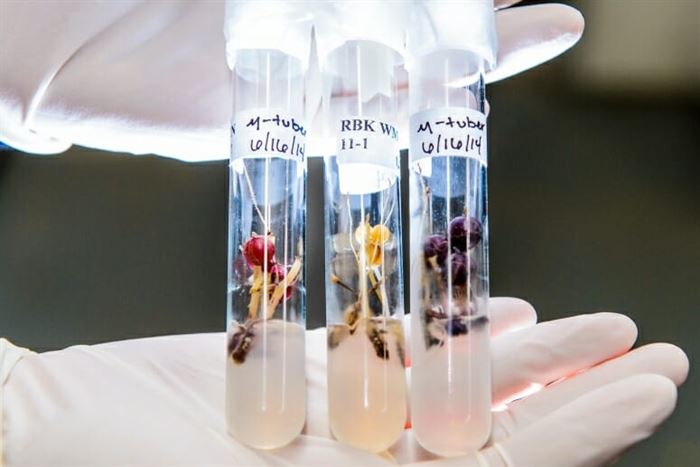11.30.17 | UW–Madison News | Natasha Kassulke | Original Publication

The National Science Foundation released its 2016 Higher Education Research and Development (HERD) Survey data, showing that UW–Madison retained 6th place in the national research rankings.
Data on UW–Madison’s 2016 expenditures for research show the university remains a research powerhouse with nearly $1.16 billion in annual expenditures for research across all fields, about half of which comes from federal awards. Federal expenditures represent a 6.3 percent increase from the previous fiscal year, or totaling nearly $34 million in new additional spending.
“The increase in expenditures and maintaining our ranking is good news for UW–Madison, showing that the needle is moving in the right direction after a four year decline in research expenditures,” says Marsha Mailick, UW–Madison vice chancellor for research and graduate education.
The HERD survey is the primary source of information on research and development expenditures at American universities and colleges. Tabulating expenditures is one way to measure academic research activity. The survey collects information on R&D expenditures by field of research and source of funds, and also gathers information on types of research expenses and number of R&D personnel. The survey is an annual census of institutions that spent at least $150,000 on separately budgeted research and development during the fiscal year.

In Fiscal 2016, more than 900 universities responded to the survey.
UW–Madison had been in the top five in the nation in research spending every year since 1972, the year the survey started, until it dropped to 6th last year.
Funding for academic research at UW–Madison comes primarily from the federal government as well as institutional funds. Additional sources include state and local government, industry, nonprofit organizations, and foundations that support the university. The two most significant private contributors of research support to UW–Madison are the Wisconsin Alumni Research Foundation (WARF) and the UW Foundation.
The university’s research enterprise is a powerful economic engine as well as a creator of knowledge and innovation. The benefits are felt throughout the state and beyond. According to the UW–Madison Data Digest for 2016-17, more than 362 UW–Madison-related startup companies support nearly 25,000 jobs, generate $113.6 million in state tax revenue and contribute $2.3 billion to the state economy.
Although the HERD Survey tracks expenditures, in Fiscal Year 2016 UW–Madison also received dozens of large awards that are leading indicators of its success in generating extramural funding.
- The U.S. Department of Energy continued its support of the Great Lakes Bioenergy Research Center (GLBRC) to develop sustainable alternatives to transportation fuels and products currently derived from petroleum.
- The U.S. Department of Education awarded a grant to UW–Madison for the Global Public Inclusive Infrastructure – Automated Personalization Computer Project as part of a global effort to create a new computer ecosystem that is easily accessible to people with disabilities, senior citizens and others with special needs.
- The National Oceanic and Atmospheric Administration continued its support of the Cooperative Institute for Meteorological Satellite Studies to conduct research using remote sensing systems for meteorological and surface-based systems.
- The National Institutes of Health funded the Inner City Asthma Consortium, a multi-study, multi-center initiative to study the causes of the urban asthma epidemic that afflicts millions of children, and develop treatments to improve control of asthma in this population and for children in general.
“Our faculty are the reason why UW–Madison is a top tier university,” says Mailick. “They are pioneers — researchers and scholars who change the world with their accomplishments. Peer universities continue to re-invest in their faculty, and we need the State of Wisconsin to do the same if we are to continue to be a top research institution.”
Part of UW–Madison’s effort to support its faculty includes new initiatives that provide seed funding for data science and microbiome projects to incentivize and support increased research funding.
“With these new initiatives and by continuing the UW2020 grant competition, we hope to position our faculty to be more competitive when applying for federal and other extramural funding for their research,” Mailick says. “The first two rounds of UW2020 projects have already generated more than $11 million in extramural funding.”
In each of the next three years, UW–Madison will also make a substantial investment to reopen the Cluster Hiring Initiative with the goal of increasing faculty size. It is anticipated that funding will be provided for about five new clusters in each of the next three years, for a total of up to 15 new faculty each year.
The purpose of cluster hires is to deepen the university’s interdisciplinary research strength in key areas of current and future research promise, and to catalyze innovative responses to contemporary problems that can only be solved through research that crosses disciplinary and methodological boundaries. An interdisciplinary cluster is a group of three faculty with overlapping research interests, typically hired across different units.